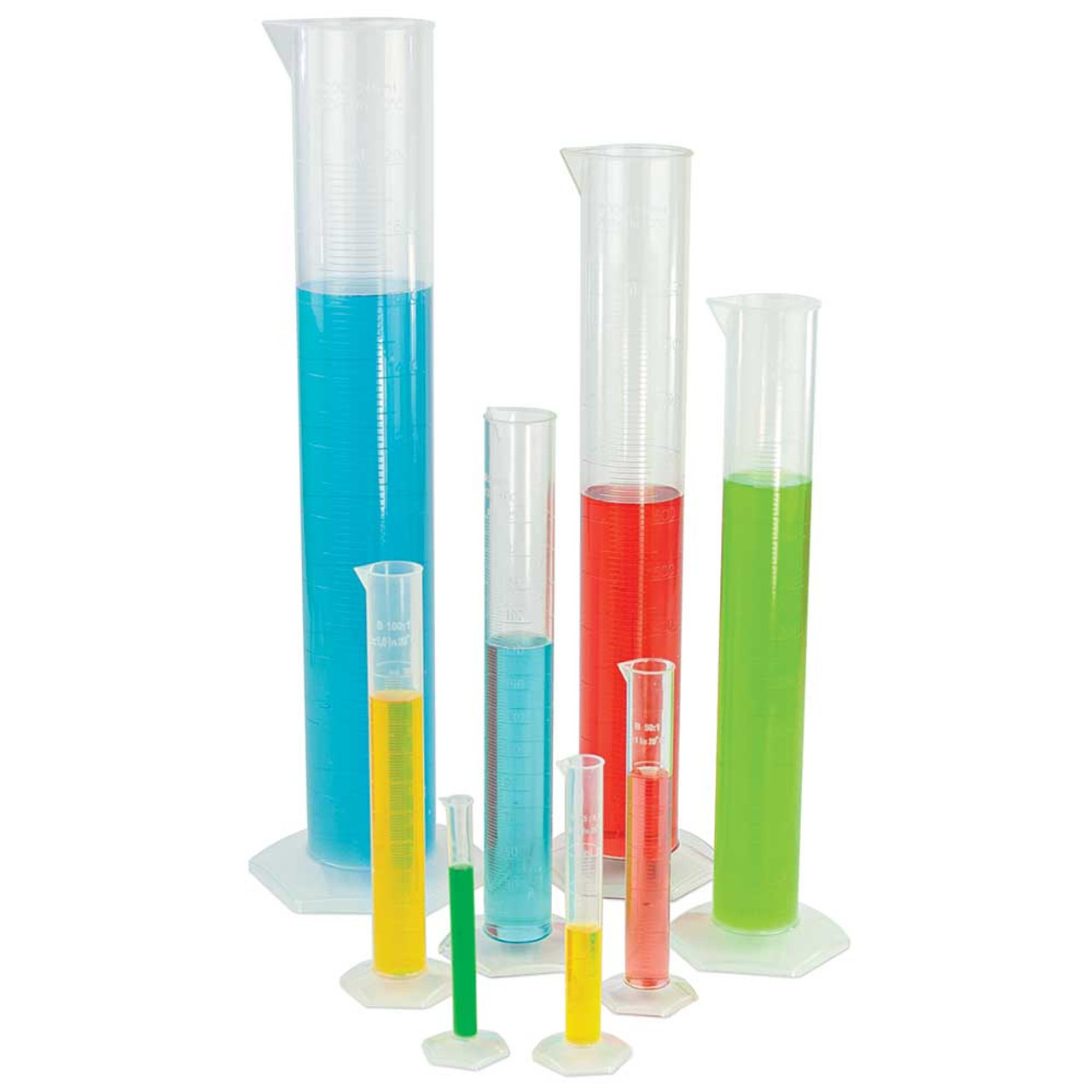Graduated cylinders, also known as “measuring cylinders”, are one of the more common pieces of laboratory containment equipment, but if you’ve been out of the lab for awhile, you might have forgotten the basics of using one.
Because they’re an easy way to accurately measure larger volumes of liquid, it’s good to have a working knowledge of proper use.
Graduated Cylinders: A Refresher Course
First things first, what are they and why is it important to distinguish them from beakers and other glassware? Cylinders are long and thin so that volumes are spread out more, which allows accurate measurements in milliliters and sometimes ounces (2).
Traditional Size Range
Small cylinders range from 5mL to 250mL, sometimes more, and are used for measuring small volumes that can be used for various molecular assays and basic chemistry experiments.
Larger ones can hold several liters and may be used to measure liquid solvents for processes like HPLC and cell culture media production.
They can be made from a couple different types of material and come in a few different styles. The thing that makes them most unique is the small divisions they use for measuring, which is ideal for determining volumes by eye.
Scientists aren’t lazy people of course, but we always love it when we can just do something by eye instead of using a more complicated system. Right?
Glass or Plastic: Materials Used and What to Choose
Graduated cylinders are typically made of either borosilicate glass, polymethylpentene (PMP) plastic, or polypropylene (1). Glass cylinders can be autoclaved at even higher temperatures than plastics and are often used for cell culture applications.
Plastics are useful when you want something sturdy that can be stored on crowded shelves and forgotten about, and they are helpful when measuring out larger volumes where drops are more likely, but they tend to wear more easily with use.
So basically, you choose plastic when you are worried about knocking it over and glass the rest of the time!
Do’s and Don’ts
Although it IS possible to measure solids with a graduated cylinder, graduated cylinders are intended for measuring liquid solvents and solutions. They allow scientists to visually calculate the volume of a liquid without the need for pipettes or other devices.
How Do You Measure Using a Cylinder?
There are a few basic rules for using a graduated cylinder to measure liquids:
- Choose a cylinder that is an appropriate size for the volume you are measuring. Don’t use a 1L cylinder to measure 20ml, choose a smaller one, like a 20ml or 50ml.
- Make sure your equipment is clean and dry first. You need to be able to see the liquid you are pouring easily and avoid contaminating substances.
- Place your cylinder on a flat surface where you can easily reach to pour and view the liquid.
- Pour your liquid until the bottom of the ring formed at the surface of the solution touches the division you are interested in measuring to.
The ring that forms is referred to as the meniscus, and you must be able to prevent “parallax”, a visual phenomenon that makes the height of the meniscus difficult to judge.
- If pouring a volatile like ethanol, make sure you cover the cylinder with film or foil afterwards to prevent evaporation if you aren’t using it immediately.
Never measure while mixing in a cylinder! They are not for mixing solutions. If you need to measure the total volume of a solution, wait until after you have already mixed it.
Class A vs. Class B Containers
Before choosing a cylinder for your experiment, be sure to check whether you intend to use Class A or B materials. Class A has more gradations between the major markers (typically three to five) and is approved for harsher chemicals.
If you need perfect measurements and the ability to withstand extended exposure to harsh chemicals, choose Class A.
Class B is made from a less durable soda glass, but it can be used for the majority of the same purposes and typically just has fewer interval lines (1).
You likely won’t need Class A glass often, but at least you will know you have all possible situations accounted for if you choose to use it.
Stellar Scientific Carries Globe™ Glass and Top Quality Plastic Cylinders
Stellar Scientific can meet all of your lab consumable needs. We carry a high-quality range of glassware and lab plastics for every purpose.
Stellar Scientific features the Globe™ glass line of graduated cylinders, designed for measuring volumes of anywhere from 5mL to 2000mL.
Class A Graduated Cylinders
Our Globe Glass Class A Graduated Cylinders incorporate a pouring mouth for easy transfer of liquids. They are Class A containers with three interval graduations capable of use for harsh chemicals and long-term containment of corrosives.
Lower-Cost Options
For less sensitive applications, Globe glass Class B cylinders can be an excellent choice. This set of Globe Glass Class B Graduated Cylinders is a cheaper alternative if you need a cylinder that can withstand high heats regularly.
Class A Plastic Containers
Are you looking for a cheaper alternative to borosilicate glass, but you can’t sacrifice the quality and accuracy of Class A consumables?
Consider one of our polymethylpentene (PMP) plastics like this Class A Plastic Graduated Cylinder which features the same sturdy base and pouring mouth and can handle harsh chemicals and temperatures up to 60°C.
They’re a lighter, safer alternative to using a glass cylinder at a much lower cost. Lab budgets are tricky sometimes, so why not play it safe?
Browse Our Catalog for More Laboratory Containers
We also offer polypropylene and bulk options. Whatever your specific glassware needs are, check out our full selection of beakers and graduated cylinders on the Stellar Scientific webpage.
Footnotes:
- Ashma Shrethsa. Graduated Cylinder: Types, Uses, and How to Use It. Microbe online 2024.
https://microbeonline.com/graduated-cylinder-types...
- What do graduated cylinders measure?. Westlab. (2023, August 31). https://www.westlab.com/blog/what-do-the-graduate...


